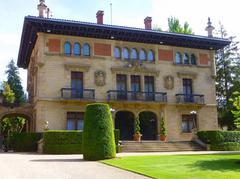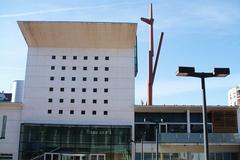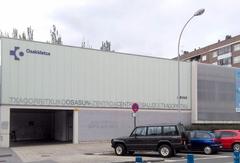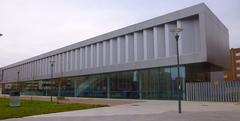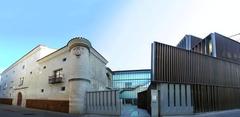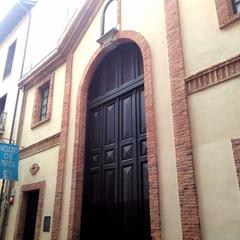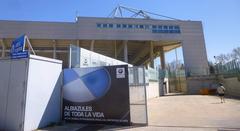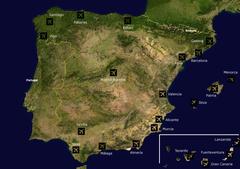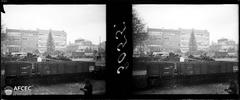
Old Quarter of Vitoria-Gasteiz: Visiting Hours, Tickets, and Historical Sites Guide
Date: 03/07/2025
Introduction
Nestled in the heart of Spain’s Basque Country, the Old Quarter of Vitoria-Gasteiz—locally known as the “Casco Viejo” or “Medieval Almond”—is a treasure trove of medieval architecture, Basque cultural heritage, and vibrant community life. Founded in 1181 by King Sancho VI of Navarre, this historic district has evolved from a strategic medieval settlement into a lively hub where centuries-old traditions meet contemporary art, gastronomy, and festivals. Visitors can wander through its almond-shaped labyrinth of narrow streets, marvel at Gothic and Renaissance landmarks, and immerse themselves in the authentic Basque way of life (Tourism Euskadi; Packing Up The Pieces).
This comprehensive guide provides detailed information on visiting hours, ticketing, accessibility, guided tours, and insider travel tips. Whether you are drawn by the city’s layered history, the celebrated pintxos culture, or its dynamic festivals and art, Vitoria-Gasteiz’s Old Quarter offers an enriching experience for every traveler (Audiala; Unstoppable Stacey Travel).
Table of Contents
- Introduction
- Historical Evolution of the Old Quarter
- Key Historical Landmarks and Visitor Information
- Practical Tips for Visitors
- Gastronomy and Social Life
- Major Festivals and Events
- Nearby Attractions and Getting There
- Frequently Asked Questions (FAQ)
- Conclusion
- References
Historical Evolution of the Old Quarter
Medieval Origins and Expansion
Vitoria-Gasteiz was founded in 1181 atop a strategic hill, originally named “Nueva Victoria.” Its unique almond-shaped plan and winding medieval streets reflect its defensive origins. Early construction included formidable stone walls, sections of which can still be explored today. Over the 13th and 14th centuries, the city expanded, welcoming a mix of merchants, artisans, and religious communities. Historic street names like Cuchillería (Cutlers’ Street) and Pintorería (Painters’ Street) recall the bustling guild life that once animated the area.
Renaissance and Baroque Transformations
From the 16th to 18th centuries, Vitoria-Gasteiz flourished as a commercial and administrative hub. The wealth of this era produced impressive Renaissance palaces (such as Palacio Escoriaza-Esquivel) and ornate Baroque churches. These structures underscore the city’s growing influence within the Kingdom of Castile and its enduring artistic legacy.
Modern Developments and Preservation
The 19th century saw significant change, particularly after the Battle of Vitoria in 1813. While modernization brought partial demolition of the ancient walls, concerted preservation efforts in the 20th century ensured that the Casco Viejo retained its medieval character, now enriched by contemporary art and sustainability projects.
Key Historical Landmarks and Visitor Information
Santa María Cathedral
A UNESCO World Heritage Site, the Santa María Cathedral is the crown jewel of the Old Quarter. Built from the late 13th century, the cathedral epitomizes Gothic architecture and is famed for its ongoing restoration, which invites visitors behind the scenes on guided hard-hat tours through crypts and scaffolding, revealing both its turbulent history and preservation efforts (Packing Up The Pieces; Tourism Euskadi).
- Visiting Hours: Tuesday to Sunday, 10:00 AM – 2:00 PM and 4:00 PM – 6:00 PM. Closed Mondays.
- Tickets: €5 per person; available online or at the Tourist Information Center in Plaza de España.
- Accessibility: Accommodations for visitors with reduced mobility.
Medieval Walls
The Old Quarter preserves impressive stretches of its 11th and 13th-century walls. Open to the public year-round, these fortifications afford panoramic views and a tangible sense of the city’s defensive past (Vitoria-Gasteiz Official Tourism).
Plaza de la Virgen Blanca
This iconic square is the city’s social hub, surrounded by historic buildings, cafés, and pintxos bars. It features the famous “Vitoria-Gasteiz” greenery sign and hosts major events like the Bajada de Celedón during the Virgen Blanca festivities (Unstoppable Stacey Travel).
Calle Cuchillería and Calle Pintorería
These parallel, cobbled streets are legendary for their pintxos bars and lively Basque taverns, forming the epicenter of Vitoria-Gasteiz’s culinary life.
BIBAT Museum Complex
Located in the Palacio de Bendaña, the BIBAT complex houses the Fournier Playing Card Museum (the world’s largest playing card collection) and the Archaeology Museum, which explores the region’s past from prehistory to the Middle Ages (Packing Up The Pieces).
- Visiting Hours: Tuesday to Saturday, 10:00 AM – 2:00 PM and 4:00 PM – 7:00 PM; Sunday, 10:00 AM – 2:00 PM; closed Mondays.
- Tickets: Free entry.
Villa Suso Palace
A Renaissance gem built in 1542, Villa Suso stands on the site of the city’s original council meeting. It now hosts art exhibitions and cultural events; climb the spiral staircase for rooftop views (Unstoppable Stacey Travel).
Casa del Cordón
A striking 15th-century palace, Casa del Cordón is recognized by its unique stone cord façade and has hosted important historical figures (Packing Up The Pieces).
- Visiting Hours: Wednesday to Sunday, 11:00 AM – 2:00 PM and 4:00 PM – 6:00 PM.
- Tickets: Free entry.
Major Churches
-
San Miguel: Overlooking Plaza de la Virgen Blanca, home to the city’s patron statue.
-
San Vicente: Known for its Renaissance interior and impressive tower.
-
San Pedro: Features remnants of the original 13th-century city wall.
-
Visiting Hours: Generally daily, 9:00 AM – 1:00 PM and 4:00 PM – 7:00 PM; check for holiday variations.
Los Arquillos
This elegant 18th-century arcade bridges the elevation between the medieval Old Quarter and the newer city, offering scenic views (The Go Guy).
Murals Route
The “Mural Itinerary” transforms the Old Quarter into an open-air gallery, with large-scale murals reflecting community life and Basque identity. Maps for self-guided mural tours are available at the Tourist Information Center (Coco Tran).
Plaza de España and Hidden Courtyards
Adjacent to Plaza de la Virgen Blanca, Plaza de España (Plaza Nueva) is a neoclassical square lined with arcades and cafés. Hidden courtyards and viewpoints throughout the Old Quarter offer unique perspectives over the city (Audiala).
Practical Tips for Visitors
- Accessibility: The quarter is pedestrian-friendly; elevators and escalators assist with hilly terrain. Cobblestones may pose challenges—wear comfortable shoes.
- Guided Tours: Bookable online or at the Tourist Information Center. Tours are offered in multiple languages and cover history, gastronomy, and art.
- Museum Entry: Most museums, including BIBAT and Casa del Cordón, are free to enter (Coco Tran).
- Maps and Apps: The Audiala app and local tourist offices provide maps and self-guided walking routes (Audiala).
- Best Times to Visit: Spring and early autumn offer pleasant weather and fewer crowds. Major festivals bring extra vibrancy.
Gastronomy and Social Life
Pintxos Culture
The Old Quarter is renowned for its pintxos bars concentrated on Calle Cuchillería and Pintorería. Locals enjoy “txikiteo”—bar-hopping to sample pintxos with drinks like txakoli (sparkling Basque white wine) or cider (StayLibere). Notable bars include El Gautxo, Idoia Bar, and Tulipán de Oro.
Traditional Basque Dishes
Restaurants serve specialties such as bacalao a la vizcaína, marmitako, txuleton, and piquillo peppers. Menus often feature local produce and Rioja Alavesa wines, with vegetarian and vegan options increasingly available.
Market Culture
The Mercado de Abastos and local specialty shops offer artisanal cheeses, cured meats, and produce, reflecting the Old Quarter’s lively food culture (StayLibere).
Major Festivals and Events
- Virgen Blanca Festivities (August): The city’s most famous festival, featuring the Bajada de Celedón, parades, music, and communal celebrations.
- Jazz Week (July): Free outdoor concerts by world-class artists (Coco Tran).
- Other Events: The Old Quarter also hosts the Vitoria-Gasteiz Jazz Festival, Azkena Rock Festival, and International Theatre Festival.
Nearby Attractions and Getting There
- Green Belt Parks: Enjoy scenic walks and cycling in the city’s renowned green spaces.
- Artium Museum: Contemporary art museum within walking distance.
- Fine Arts Museum: Showcasing regional and national art.
The Old Quarter is easily accessible by foot from the city center. Public transportation, bike rentals, and nearby parking garages provide convenient options.
Frequently Asked Questions (FAQ)
Q: Are there entrance fees for the Old Quarter?
A: The Old Quarter is a public area with free access. Some landmarks and museums require tickets.
Q: What are the typical visiting hours for attractions?
A: Most open from 10:00 AM to 6:00 PM. Outdoor sites like walls and plazas are open 24/7.
Q: Are guided tours available?
A: Yes, through local operators and the Tourist Information Center.
Q: Is the Old Quarter suitable for children and elderly visitors?
A: Yes, though cobblestones and steep streets may require planning.
Q: Are vegetarian and vegan options available?
A: Increasingly so; look for restaurants like El Parral and Black Salad.
Q: How can I purchase tickets for major sites?
A: Online or at the Tourist Information Center at Plaza de España.
Conclusion
The Old Quarter of Vitoria-Gasteiz is a living tapestry of Basque history, culture, and gastronomy. From guided tours of the Santa María Cathedral and panoramic walks atop medieval walls to vibrant festivals and pintxos crawls, every corner offers a new discovery. With accessible ticketing, free-entry museums, and a welcoming community, planning your visit is easy and rewarding.
For interactive maps, self-guided tours, and event updates, download the Audiala app. Explore related articles for more Basque Country travel inspiration and follow us on social media for real-time tips and offers.
References
- Packing Up The Pieces, 2024, Best Things to Do in Vitoria-Gasteiz
- Tourism Euskadi, Old Quarter of Vitoria-Gasteiz
- Unstoppable Stacey Travel, Things to Do in Vitoria-Gasteiz Attractions
- Audiala, Vitoria-Gasteiz Attractions and Tours
- StayLibere, Gastronomic Guide to Vitoria
- Coco Tran, Vitoria-Gasteiz Attractions
- The Go Guy, 25 Best Things to Do in Vitoria-Gasteiz
- Gamintraveler, Mistakes to Avoid in Basque Country
- RestaurantGuru, Vitoria-Gasteiz












